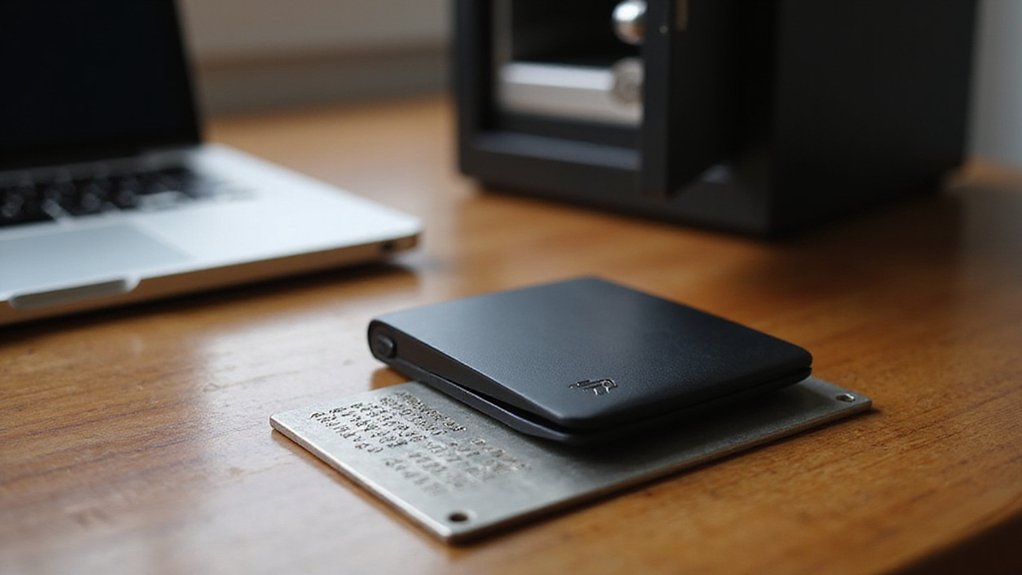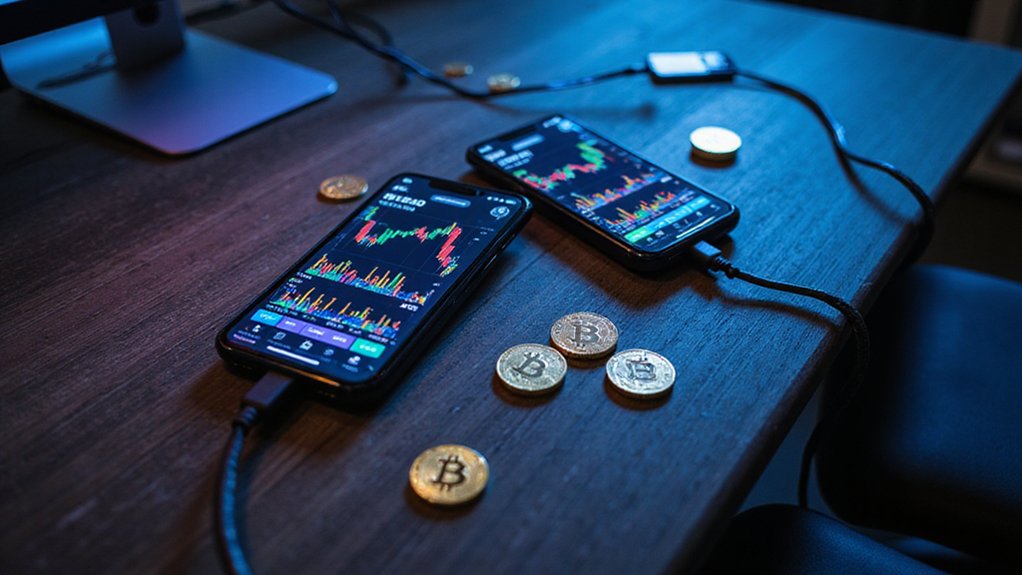Cryptocurrency storage fundamentally divides between hot wallets (internet-connected for convenience) and cold wallets (offline for security), with hardware options like Ledger Nano X and Trezor Safe 3 providing the gold standard for asset protection. Software alternatives including MetaMask and Coinbase Wallet offer accessibility but increase vulnerability to cyberattacks. Best practices demand physical seed phrase backups, geographically separated storage, and address verification before transfers—because one misplaced private key transforms digital wealth into expensive lessons about the unforgiving nature of blockchain immutability, though mastering these fundamentals merely scratches the surface of thorough crypto security architecture.

Why do investors who meticulously research every stock purchase often treat their cryptocurrency like loose change in a digital couch cushion? This cavalier approach to digital asset security represents perhaps the most glaring disconnect between traditional and crypto investing practices.
The fundamental choice between hot and cold storage determines your security posture. Hot wallets—those perpetually connected to the internet—offer convenience at the expense of vulnerability to cyberattacks. Cold wallets, conversely, isolate private keys offline, creating an air gap between your assets and potential hackers (though admittedly making impulse trading considerably more cumbersome).
The security-convenience trade-off in crypto storage isn’t theoretical—it’s the defining choice that separates cautious investors from future hack victims.
Hardware wallets represent the gold standard for cold storage, with devices like the Ledger Nano X providing beginner-friendly interfaces without sacrificing security. For those prioritizing maximum protection over convenience, NGrave Zero caters to advanced users willing to navigate additional complexity. Budget-conscious investors might consider the Trezor Safe 3, which effectively balances cost and security—a rare achievement in the crypto ecosystem.
Software solutions like MetaMask and Coinbase Wallet serve different purposes. MetaMask supports over 650,000 Ethereum-based tokens and integrates with hardware wallets for enhanced security, while Coinbase Wallet offers seamless exchange integration alongside DeFi staking capabilities. Crypto.com Onchain Wallet distinguishes itself by supporting more than 1,000 assets while providing staking and DeFi capabilities. Multi-signature wallets add another security layer by requiring multiple approvals for transactions, though they introduce operational complexity.
The cardinal rule remains unchanged: never digitally store seed phrases or private keys. Physical backups using metal storage devices or paper wallets provide protection against environmental hazards, while geographically separated storage mitigates regional risks. Safety deposit boxes and home safes offer superior security compared to desk drawers (shocking, perhaps, but worth stating). Physical and software wallets differ significantly in their security and functionality, requiring careful consideration of your specific needs and risk tolerance.
Transaction security demands constant vigilance. Verifying wallet addresses before transfers prevents costly mistakes, while two-factor authentication adds essential access protection. Implementing robust security protocols significantly reduces the risk of unauthorized access and protects against sophisticated hacking attempts. Public Wi-Fi networks and cryptocurrency wallets mix about as well as day trading and retirement planning—which is to say, poorly.
The ideal strategy combines both storage types: cold wallets for long-term holdings and hot wallets for frequent transactions. This hybrid approach acknowledges that perfect security often conflicts with practical usability, requiring investors to make informed trade-offs rather than pretending such tensions don’t exist.
Frequently Asked Questions
What Happens to My Cryptocurrency if I Forget My Wallet Password?
Forgetting a cryptocurrency wallet password typically results in permanent loss of access to one’s digital assets—a rather unforgiving consequence of decentralization’s “be your own bank” ethos.
Unlike traditional financial institutions with their customer service departments and password reset protocols, cryptocurrency wallets offer no central authority for recovery assistance.
Recovery remains possible through seed phrases or private keys (assuming proper storage), though many investors discover this backup wisdom retrospectively.
Can I Recover My Funds if My Hardware Wallet Gets Damaged?
Yes, funds remain recoverable despite hardware wallet damage—assuming one previously heeded the oft-ignored advice to secure their recovery phrase.
The device itself merely stores private keys; the actual cryptocurrency exists on the blockchain.
With the 12-24 word recovery phrase, users can restore access through compatible wallet software on replacement devices.
However, those who neglected this fundamental backup step (surprisingly common) face permanent loss, rendering expensive hardware utterly worthless.
Should I Tell Family Members About My Cryptocurrency Storage Methods?
Cryptocurrency holders face a delicate balance between operational security and estate planning necessity.
While sharing storage methodologies introduces obvious attack vectors, complete secrecy renders assets effectively worthless upon incapacitation or death—a rather pyrrhic victory over potential thieves.
The best approach involves structured disclosure through legal instruments (trusts, wills) rather than casual family conversations, ensuring controlled access while maintaining security protocols that previously protected against hardware wallet catastrophes.
How Often Should I Update My Wallet Software for Security?
Wallet update frequency depends entirely on type and connectivity.
Hot wallets demand immediate attention when security patches emerge—delaying such updates borders on financial masochism.
Cold storage requires quarterly checks at minimum, though the irony of “updating” offline devices isn’t lost on seasoned holders.
Software wallets connected to exchanges will nag users incessantly (and rightfully so), while hardware manufacturers recommend scheduled reviews.
Ignoring updates transforms secure storage into elaborate digital paperweights.
Is It Safe to Store Cryptocurrency on Multiple Different Platforms?
Storing cryptocurrency across multiple platforms represents sound risk management—though one might marvel at needing such diversification in supposedly “revolutionary” financial technology.
This approach mitigates single-point-of-failure risks inherent in centralized exchanges while enabling strategic positioning across DeFi protocols.
The key lies in balancing convenience against security exposure, maintaining cold storage for substantial holdings while distributing operational amounts across vetted platforms with robust security frameworks and insurance coverage.









